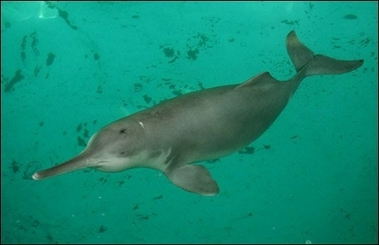| Home / Environment / Ecology and China | Tools: Save | Print | E-mail | Most Read |
| 'Extinct' Dolphin Spotted in Yangtze River |
| Adjust font size: |
A white-flag dolphin was seen in the Yangtze River in east China, just days after a leading Chinese scientist said the animal was likely extinct. A man with a decoration company in east China's Anhui Province spotted a "big white animal" in the river at the Xuba ferry in Tongling, Anhui, from 3:10 to 3:20 pm August 19, and filmed it with a digital camera, said Dr. Wang Kexiong from the Institute of Hydrobiology of the Chinese Academy of Sciences.
A baiji dolphin (file photo) Based on its appearance and living environment, the animal in the footage was confirmed by the institute to be a white-flag dolphin, known in Chinese as "baiji," Wang said. "We are very glad to see baiji still exist in the world," Wang said. "Many people have believed that baiji is extinct and this finding brings us a sliver of hope," said Wang Ding, a leading expert on the species from the hydrobiology institute of the Chinese Academy of Sciences. But he noted that it is still quite difficult to protect the endangered animal. Because so few of this species still live in the Yangtze River, their chance of mating is slim, said Wang Ding, who added that one proposed protection measure is to gather these animals in one section of the river for breeding. "This is no easy task. But if we don't do that, white-flag dolphins are doomed to go extinct," he said. Zeng Yujiang, the man who spotted the dolphin, told Xinhua, "I never saw such a big thing in the water before, so I filmed it. It was about 1,000 meters away and jumped out of the water several times." The footage was sent to the Tongling freshwater dolphin nature reserve to determine what the animal was. A staff member with the Institute of Hydrobiology of the Chinese Academy of Sciences, who happened to be at the nature reserve, then brought the footage to the institute based in Wuhan, capital of central China's Hubei Province, which is renown for research on baiji. The white-flag dolphin, unique to China's Yangtze River, is listed as one of the 12 most endangered species in the world. Its population dropped to below 150 in the early 1990s from around 400 a decade earlier. A team of 25 scientists from China, the United States, Britain, Japan, Germany and Switzerland failed to find any white-flag dolphins during a 38-day search last year. Wang Ding, a leading expert on the species from the hydrobiology institute of the Chinese Academy of Sciences and head of the team, said earlier this month, "This result means the baiji is likely extinct." Before the search, scientists had estimated there would be no more than 50 dolphins in the river, a prediction that appears wildly optimistic. If the white-flag dolphin is extinct, it will be the first cetacean to vanish as a result of human activity as it is on the top of the food chain in the Yangtze River and has no natural enemy, according to Wang Ding. The professor is planning a trip to Tongling with some experts. "I hope we can find that white-flag dolphin," he said. (Xinhua News Agency August 30, 2007) |
| Tools: Save | Print | E-mail | Most Read |
 |
| Related Stories |

